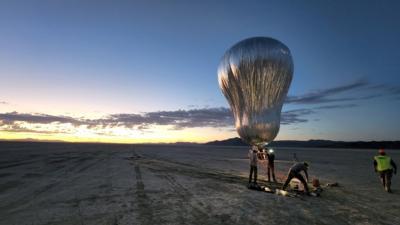Thu, Oct 13, 2022
Atmospheric Assestment System in Development for Venutian Exploration
The Jet Propulsion Laboratory completed the first of a battery of test flights for their prototype aerial robotic balloon.

The system is hoped to help uncover atmospheric conditions on the planet Venus, deploying the balloon into the intense heat, pressure, and corrosive gases found in its environment. The balloon is a part of a concept that pairs it with an orbiting platform outside the atmosphere. The duo would allow the orbiting portion to function as a communications relay while allowing the robotic balloon, or "aerobot" , to descend into the atmosphere proper and act as a submerged analysis platform.
The idea is promising enough for the JPL to begin work on preliminary designs that would see the aerobot make humanity’s best observation of Venus in decades, following up on a balloon-borne survey done underthe Soviet’s Vega mission in 1985. Those balloons lasted only 46 hours before losing power, a record that should be handily outperformed with modern technology - provided, of course, that they’re hardy enough to survive. The ultimate goal for NASA is to create an aerobot that can travel by riding the Venusian winds, circumnavigating the planet for at least 100 days while monitoring the planet with as many sensors as they can pack aboard.
The Jet Propulsion Lab tested the general concept with the assistance of the Near Space Corporation to assess the feasibility of a smaller 1/3 scale demonstrator over Nevada's Black Rock Desert. The test saw the silvery aerobot ascent to 4,000 feet, roughly equivalent to the atmospheric conditions found at 180,000 ft AGL on Venus. The prototype appears to have been a success, ascending and holding altitude before coming back down to earth with the trademark grace of lighter-than-air aircraft.
“We’re extremely happy with the performance of the prototype. It was launched, demonstrated controlled-altitude maneuvers, and was recovered in good condition after both flights,” said robotics technologist Jacob Izraelevitz, who leads the aerobot's development as the JPL principal investigator over flight testing. “We’ve recorded a mountain of data from these flights and are looking forward to using it to improve our simulation models before exploring our sister planet."
More News
Aero Linx: The American Society of Aerospace Medicine Specialists (ASAMS) The Society is a non-profit organization created to serve as a voice for and represent the professional ne>[...]
Class C Service This service provides, in addition to basic radar service, approved separation between IFR and VFR aircraft, and sequencing of VFR aircraft, and sequencing of VFR a>[...]
Have A Story That NEEDS To Be Featured On Aero-News? Here’s How To Submit A Story To Our Team Some of the greatest new stories ANN has ever covered have been submitted by our>[...]
Also: ERAU Uses UAVs, P550 Group 2 UAS, Starship’s Florida Launches, NASA Missions Chopped The Air Force has put out a call to commission a one-to-one copy of the Iranian-des>[...]
Classic Klyde Morris From 11.07.16 (and Remembering Bob...) FMI: www.klydemorris.com>[...]
 ANN's Daily Aero-Linx (08.27.25)
ANN's Daily Aero-Linx (08.27.25) ANN's Daily Aero-Term (08.27.25): Class C Service
ANN's Daily Aero-Term (08.27.25): Class C Service ANN FAQ: Submit a News Story!
ANN FAQ: Submit a News Story! Airborne-NextGen 08.26.25: Iran UAV Knockoffs, X-37B Spaceplane, Army Training
Airborne-NextGen 08.26.25: Iran UAV Knockoffs, X-37B Spaceplane, Army Training Classic Klyde Morris (08.25.25)
Classic Klyde Morris (08.25.25)



